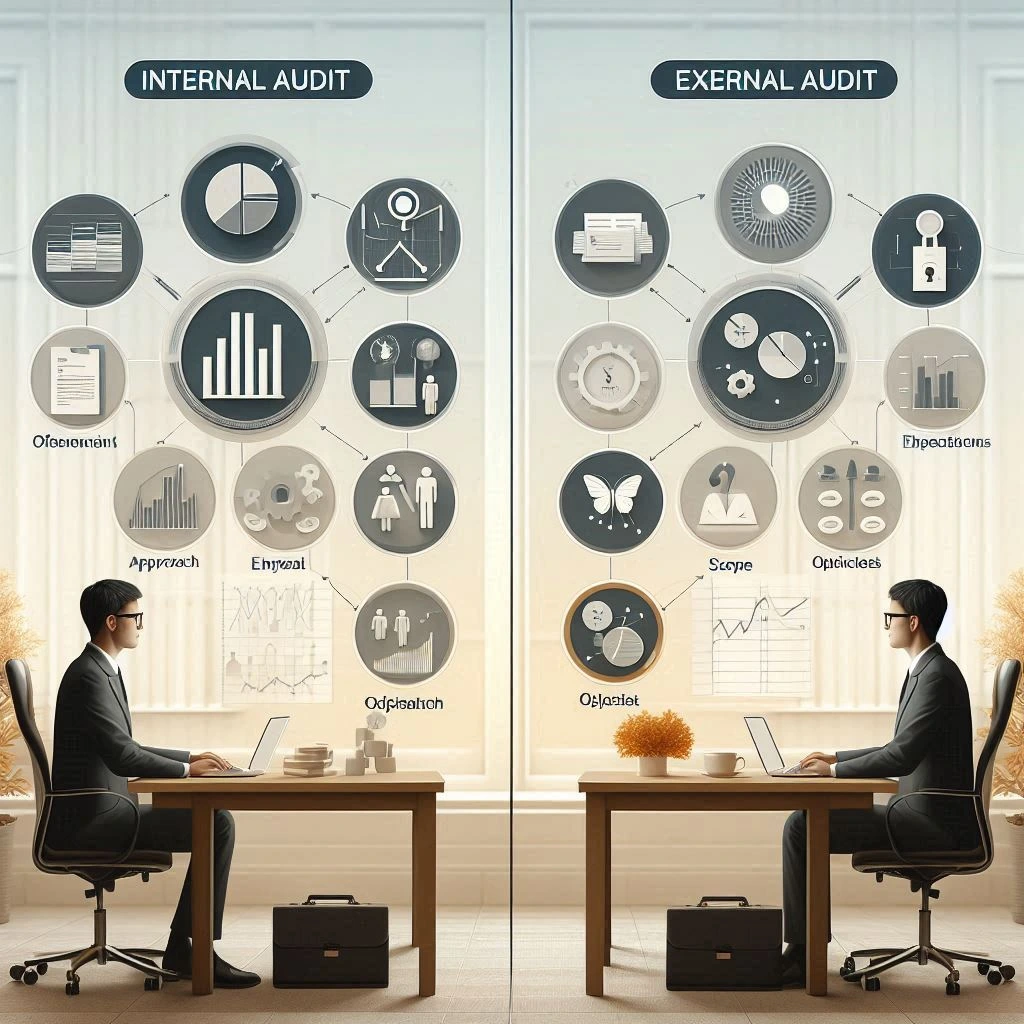In the realm of organizational governance, audits play a pivotal role in ensuring compliance, enhancing operational efficiency, and providing stakeholders with a clear view of an entity’s financial health. Understanding the distinctions, such as the difference between internal and external auditor roles, is essential for audit methodology experts and practitioners, as each type serves unique purposes and employs different approaches.
Defining Internal and External Audits
Internal audits are conducted by employees within the organization, focusing on evaluating and improving internal control systems, risk management processes, and operational efficiencies. Their primary objective is to provide management with insights that can enhance the organization’s operations and ensure compliance with internal policies and regulations [4][10]. In contrast, external audits are performed by independent third-party auditors who assess the accuracy and fairness of an organization’s financial statements. These audits are often mandatory and aim to provide assurance to stakeholders, including investors and regulatory bodies, regarding the integrity of financial reporting [3][12].
The Role of Auditors in Compliance and Operational Efficiency
Both internal and external auditors play crucial roles in maintaining compliance and enhancing operational efficiency. Internal auditors work closely with management to identify areas for improvement, assess risks, and ensure that the organization adheres to its policies and regulatory requirements. Their continuous engagement allows for timely adjustments and proactive measures to mitigate risks [8][14]. On the other hand, external auditors provide an independent assessment of financial statements, ensuring that they are free from material misstatements and comply with applicable accounting standards. This independent verification is vital for maintaining stakeholder trust and fulfilling legal obligations [2][15].
The Need for Comparing Methodologies
Given the distinct roles and methodologies of internal and external audits, it is essential to compare their approaches. Understanding these differences not only aids in optimizing audit processes but also enhances the overall governance framework of an organization. By examining the methodologies employed by both internal and external auditors, practitioners can identify best practices, streamline audit functions, and ultimately contribute to a more robust organizational structure [1][6]. This comparison will set the stage for a deeper exploration of the methodologies used in internal and external audits, highlighting their respective strengths and areas for improvement.
Understanding Internal Auditors
Internal auditors play a crucial role within organizations, serving as independent evaluators of the effectiveness of risk management, governance, and internal control processes. Their primary objective is to provide management with insights that can enhance operational efficiency and ensure compliance with internal policies and regulations.
Role of Internal Auditors
- Independence and Objectivity: Internal auditors are typically employees of the organization, which allows them to have a deep understanding of the company’s operations and culture. However, they must maintain independence from the areas they audit to provide unbiased assessments [9][12].
- Support for Management: They assist management by identifying areas of risk and recommending improvements to processes and controls, thereby contributing to the strategic objectives of the organization [5][14].
Internal Audit Process
The internal audit process generally consists of three main phases:
- Planning Phase: This initial stage involves defining the scope of the audit, identifying key risks, and developing an audit plan. Internal auditors assess the areas that require attention based on risk assessments and organizational priorities [2].
- Execution Phase: During this phase, auditors conduct fieldwork, which includes gathering evidence, testing controls, and evaluating the effectiveness of processes. This hands-on approach allows auditors to identify weaknesses and areas for improvement.
- Reporting Phase: After completing the fieldwork, internal auditors compile their findings into a report. This report outlines the audit results, recommendations for improvement, and any identified risks. It is then presented to management and, in some cases, the board of directors.
Focus Areas
Internal auditors concentrate on several key areas:
- Risk Management: They evaluate the organization’s risk management processes to ensure that risks are identified, assessed, and mitigated effectively [14].
- Compliance: Internal auditors assess compliance with internal policies and external regulations, ensuring that the organization adheres to legal and ethical standards.
- Operational Efficiency: By analyzing processes and controls, internal auditors provide insights that can lead to improved operational efficiency and effectiveness [13].
Tools and Techniques
Internal auditors utilize a variety of tools and techniques to conduct their audits effectively:
- Data Analytics: Many internal auditors employ data analytics to identify trends, anomalies, and areas of concern within financial and operational data [14].
- Risk Assessment Frameworks: They often use established risk assessment frameworks to guide their evaluations and ensure a comprehensive approach to risk management.
- Control Testing: Internal auditors perform control testing to assess the effectiveness of internal controls and identify any weaknesses that need to be addressed.
Internal auditors are integral to an organization’s governance framework, providing valuable insights that help enhance risk management, compliance, and operational efficiency. Their methodologies, which include a structured audit process and the use of various tools, enable them to deliver objective assessments that support management in achieving strategic goals.
Understanding External Auditors
External auditors play a crucial role in the financial ecosystem of organizations by providing an independent assessment of financial statements and compliance with regulatory requirements. Their methodologies are distinct from those of internal auditors, focusing primarily on objectivity and adherence to established standards.
Role of External Auditors
- Independence: External auditors are independent third-party professionals who are not employed by the organization they audit. This independence is vital as it ensures that their assessments are unbiased and objective, fostering trust among stakeholders such as investors, creditors, and regulatory bodies [5][12].
- Objective Assessment: Their primary responsibility is to evaluate the accuracy and fairness of financial statements, ensuring that they reflect the true financial position of the organization. This includes verifying that the financial reports comply with relevant accounting principles and regulations [11][15].
External Audit Process
The external audit process typically involves several key phases:
Planning: This initial phase includes understanding the organization’s operations, assessing risks, and determining the scope of the audit. External auditors develop an audit plan that outlines the objectives, resources needed, and timelines for the audit [8][10].
Execution: During this phase, auditors perform fieldwork, which involves gathering evidence through various methods such as interviews, observations, and testing transactions. This step is critical for assessing the effectiveness of internal controls and identifying any areas of concern [12].
Reporting: After completing the audit, external auditors compile their findings into a formal report. This report includes their opinion on the financial statements, highlighting any discrepancies or areas of non-compliance. The report is then presented to the organization’s management and stakeholders, providing transparency and accountability [4][11].
Focus Areas
- Financial Statement Audits: External auditors primarily focus on financial statement audits, which assess the accuracy of financial reports. This involves examining the organization’s financial records, transactions, and internal controls to ensure that the financial statements are free from material misstatement, whether due to fraud or error [3][11].
- Regulatory Compliance: In addition to financial accuracy, external auditors evaluate the organization’s compliance with applicable laws and regulations. This is essential for maintaining the integrity of financial reporting and ensuring that the organization adheres to industry standards [15].
Standards and Frameworks
External audit practices are guided by various standards and frameworks, which ensure consistency and quality in the audit process:
- Generally Accepted Auditing Standards (GAAS): These standards provide a framework for conducting audits in the United States, outlining the responsibilities of auditors and the criteria for evaluating audit quality [11].
- International Standards on Auditing (ISA): For audits conducted outside the U.S., ISAs provide a globally recognized set of guidelines that govern the audit process, ensuring that external auditors maintain high levels of professionalism and integrity [15].
External auditors serve as independent evaluators of an organization’s financial health and compliance with regulations. Their methodologies, characterized by a structured process of planning, execution, and reporting, are underpinned by established standards that enhance the credibility of financial reporting. Understanding these distinctions is essential for audit methodology experts and practitioners aiming to navigate the complexities of audit practices effectively.
Methodological Differences
In the realm of auditing, internal and external auditors employ distinct methodologies that reflect their differing objectives, planning processes, data analysis techniques, and reporting formats. Understanding these differences is crucial for audit methodology experts and practitioners, as it informs best practices and enhances the effectiveness of audit functions.
Objectives of Internal vs. External Audits
- Internal Audits: The primary objective of internal audits is to enhance operational efficiency and effectiveness within an organization. Internal auditors focus on risk management, governance, and operational improvement, serving as a tool for management to refine internal processes and controls [11]. Their work is aimed at providing assurance over internal controls and adding value to the organization [1].
- External Audits: In contrast, external audits are primarily concerned with the accuracy and fairness of financial statements. External auditors assess the financial records of an organization to ensure compliance with generally accepted accounting principles (GAAP) and provide an independent opinion to stakeholders, including shareholders and regulatory authorities [6][12]. This focus on financial integrity distinguishes external audits from the operational emphasis of internal audits.
Audit Planning and Risk Assessment Approaches
- Internal Auditors: The planning phase for internal audits often involves a detailed risk assessment that identifies specific areas of concern within the organization. Internal auditors may tailor their approach based on the unique risks associated with different departments or processes, allowing for a more focused examination of internal controls and operational efficiencies [5].
- External Auditors: External auditors, on the other hand, typically conduct a broader risk assessment that encompasses all relevant financial information. Their planning process is influenced by the need to comply with regulatory requirements and to provide a comprehensive overview of the organization’s financial health. This often involves a standardized approach to ensure consistency and reliability across audits [4].
Methodologies in Data Gathering and Analysis
- Internal Audit Methodologies: Internal auditors utilize a variety of methodologies for data gathering, including interviews, surveys, and direct observation of processes. They may also employ analytical procedures to assess the effectiveness of internal controls and identify areas for improvement. The analysis is often qualitative, focusing on operational processes and risk management strategies [11].
- External Audit Methodologies: External auditors primarily rely on quantitative data analysis, examining financial records and transactions to verify accuracy and compliance. Their methodologies often include substantive testing and analytical procedures that are designed to detect material misstatements in financial statements. This rigorous approach ensures that external auditors can provide a reliable opinion on the financial health of the organization [12].
Reporting Formats and Follow-Up Processes
- Internal Audit Reporting: The internal audit report typically includes an evaluation of the effectiveness of internal controls, risk management, and governance processes, along with actionable recommendations for improvement. Internal auditors often present their findings directly to management, fostering a collaborative environment for implementing changes [12].
- External Audit Reporting: In contrast, external auditors produce a formal audit report that is presented to shareholders and regulatory authorities. This report includes an opinion on the financial statements and is subject to strict regulatory standards. Follow-up processes for external audits may involve additional scrutiny from stakeholders, as external auditors are accountable to a broader audience [10].
The methodologies employed by internal and external auditors reflect their distinct objectives and approaches. Internal auditors focus on operational improvements and risk management, while external auditors emphasize financial accuracy and compliance. Understanding these methodological differences is essential for audit professionals seeking to enhance their practices and ensure effective audit outcomes.
Regulatory Frameworks and Standards
In the realm of auditing, both internal and external auditors operate under distinct regulatory frameworks and standards that shape their methodologies and practices. Understanding these frameworks is crucial for audit methodology experts and practitioners, as they influence the effectiveness and reliability of audit processes.
Standards Applicable to Internal Audits
Internal audits are primarily guided by the International Internal Audit Standards set forth by the Institute of Internal Auditors (IIA). These standards emphasize the importance of independence, objectivity, and a systematic approach to evaluating and improving the effectiveness of risk management, control, and governance processes. Key aspects include:
- Independence and Objectivity: Internal auditors must maintain independence from the activities they audit to ensure unbiased assessments. This is crucial for fostering trust and credibility within the organization [3].
- Risk-Based Approach: Internal audits are often conducted based on a risk assessment, allowing auditors to focus on areas with the highest potential for impact on the organization’s objectives [15].
- Continuous Improvement: The IIA standards encourage internal auditors to provide recommendations for enhancing internal controls and processes, thereby contributing to the organization’s overall performance [12].
Standards Applicable to External Audits
External audits, on the other hand, are governed by a different set of standards, primarily the Public Company Accounting Oversight Board (PCAOB) standards in the United States and the International Standards on Auditing (ISA) globally. These standards focus on ensuring the accuracy and reliability of financial statements. Key elements include:
- Independence: External auditors must be independent from the entity they audit, which is essential for providing an unbiased opinion on the financial statements [4].
- Regulatory Compliance: External audits are often mandated by regulatory bodies, requiring adherence to specific standards to ensure compliance with laws and regulations [8].
- Opinion on Financial Statements: The primary objective of external audits is to express an opinion on the fairness of the financial statements, which is critical for stakeholders such as investors and regulators [10].
Implications of Frameworks on Audit Methodologies
The differing regulatory frameworks and standards for internal and external audits have significant implications for their methodologies:
- Scope and Focus: Internal audits tend to have a broader scope, encompassing operational efficiency and risk management, while external audits are narrowly focused on financial statement accuracy and compliance [5][11].
- Frequency and Timing: Internal audits are continuous and ongoing, allowing for real-time assessments and adjustments, whereas external audits are typically conducted annually or at specific intervals [15].
- Reporting Structure: Internal auditors report their findings to management and the board, aiming for improvement, while external auditors report to shareholders and regulatory authorities, emphasizing accountability and compliance [12].
The regulatory frameworks and standards governing internal and external audits not only define their respective methodologies but also shape the overall audit landscape. Understanding these differences is essential for audit professionals aiming to enhance their practices and ensure compliance with applicable regulations.
Collaboration Between Internal and External Auditors
In the realm of auditing, the collaboration between internal and external auditors is crucial for enhancing the overall effectiveness of the audit process. Both functions, while distinct in their roles and methodologies, can significantly benefit from working together. Here are some key points to consider regarding their collaboration:
Areas of Collaboration
- Access to Information: Internal auditors can provide external auditors with access to internal audit reports and data, which can streamline the external audit process. This access allows external auditors to gain a deeper understanding of the organization’s internal controls and risk management practices, facilitating a more efficient audit [6][10].
- Joint Planning and Coordination: By scheduling regular meetings and joint planning sessions, internal and external auditors can align their audit objectives and methodologies. This coordination helps in identifying overlapping areas of focus, reducing redundancy, and ensuring that both audits complement each other [4][5].
- Fieldwork Support: During the fieldwork phase, internal auditors can assist external auditors by providing insights into the organization’s operations and facilitating access to employees and data. This collaboration can enhance the quality of the audit findings and recommendations [3][9].
Benefits of Sharing Insights, Methodologies, and Data
- Enhanced Risk Assessment: By sharing insights and methodologies, both internal and external auditors can improve their risk assessment processes. Internal auditors, who are more familiar with the day-to-day operations, can provide valuable context that external auditors may lack, leading to a more comprehensive evaluation of risks [12][14].
- Improved Audit Quality: Collaboration fosters a culture of continuous improvement. By exchanging best practices and methodologies, both internal and external auditors can enhance the quality of their audits. This synergy can lead to more robust findings and recommendations, ultimately benefiting the organization [8][11].
- Cost Efficiency: Working together can lead to cost savings for the organization. By coordinating their efforts, internal and external auditors can minimize duplication of work, thereby reducing the overall time and resources spent on audits [5].
The collaboration between internal and external auditors is not only beneficial but essential for a comprehensive audit approach. By identifying areas of synergy, sharing insights, and learning from successful case studies, organizations can enhance their audit methodologies and ultimately improve their operational effectiveness.
Conclusion
In the realm of auditing, understanding the distinctions between internal and external auditors is crucial for organizations aiming to enhance their financial integrity and operational efficiency. Here’s a recap of the main differences between these two types of auditors:
- Independence and Employment: Internal auditors are typically employees of the organization, focusing on internal processes and risk management, while external auditors are independent third-party professionals who assess the accuracy of financial statements and compliance with regulations [5][15].
- Scope and Focus: Internal audits concentrate on specific areas within the organization, aiming to improve processes and mitigate risks. In contrast, external audits encompass a broader scope, evaluating all relevant financial information to provide an unbiased view of the company’s financial health [3][4][12].
- Objective: The primary goal of internal audits is to enhance operational efficiency and ensure compliance with internal policies, whereas external audits aim to provide assurance to stakeholders regarding the accuracy of financial statements [6].
Choosing the right audit approach is essential for meeting organizational needs. Internal audits can facilitate continuous improvement and risk management, while external audits offer an independent assessment that can bolster stakeholder confidence. Organizations must assess their specific requirements and regulatory obligations to determine the most suitable auditing methodology.
Moreover, the audit profession is dynamic, and methodologies must evolve to address emerging challenges and changes in the business environment. Practitioners are encouraged to engage in ongoing learning and adaptation of their auditing practices. This commitment to professional development not only enhances the effectiveness of audits but also contributes to the overall integrity and success of the organization. By understanding and leveraging both internal and external audit methodologies, organizations can better navigate the complexities of financial oversight and governance.
Find out more about Shaun Stoltz https://www.shaunstoltz.com/about/
This post was written by an AI and reviewed/edited by a human.



